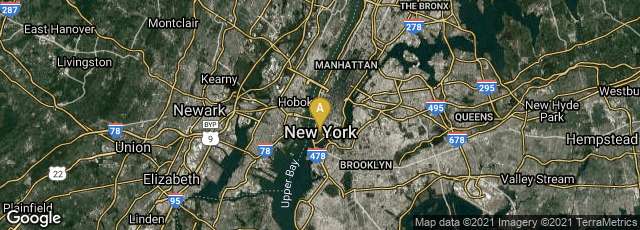
A: Manhattan, New York, New York, United States
"The new, computerized typesetting machines unleashed anxiety within the I.T.U....
"One hundred and fifty blind, crippled, and elderly newsdealers were forced out of business; 5,000 hotel and restaurant workers were discharged; welfare agencies reported that, without the ads they placed in newspapers, offers to take in orphaned and needy children dropped from roughly 100 per month to zero; charity balls were canceled. Without printed obituaries, attendance at wakes and funerals declined, and flower shops suffered. “A lot of people just don’t know when their friends die,” a florist told Newsweek. Promotion, like nature, abhors a vacuum, and as Christmas approached, improvisation filled the void. In the windows of Stern’s Department Store, attractive models scrawled daily specials on blackboards. On Madison Avenue, employees from a P.R. firm held up signs with the latest news and gossip about their clients....
"A city without newspapers was a city in which civic activity was impeded, as two out-of-work Times reporters hired by the Columbia Journalism Review soon documented. Without the daily papers, the Health Department’s campaign against venereal disease was “seriously impaired.” So was the fight against slumlords: “There’s a distinct difference,” the city’s building commissioner said, “between a $500 fine and a $500 fine plus a story in the Times.” The New York chapter of the Congress on Racial Equality discovered that, without newspaper attention, its boycott of the Sealtest Milk Company was considerably undermined. The newspaper strike, the C.J.R. study concluded, had “deprived the public of its watchdog.”
‘It was one of those stalemate situations,” says Gabe Pressman, the venerable New York television journalist. “It went on day after day, week after week. We thought it would be over quickly, but it wasn’t.” The round-the-clock negotiations encompassed a cast that included Governor Nelson Rockefeller, Supreme Court Justice Arthur J. Goldberg, and New York City mayor Robert F. Wagner. But nothing and no one could break the deadlock, prompting Wagner to declare, “Both sides deserve each other....
"During those 114 days, jobless newspaper workers hauled laundry, drove cabs, shoveled coal, and sorted mail. Some reporters worked on short-lived strike papers. A few with particular talent and flair—such as Walter Kerr and Judith Crist, of the Herald Tribune—were hired by local TV stations, which expanded their beachhead in the news-and-culture business. On the Upper West Side, a cluster of editors and writers—Robert Silvers, Jason and Barbara Epstein, and Robert Lowell and Elizabeth Hardwick—took advantage of the strike to launch a highbrow, London-style literary periodical, The New York Review of Books. All of them had long despaired of the quality of the city’s literary supplements and were fully aware that the strike had deprived book publishers of venues in which they could advertise. “One morning in January,” Robert Silvers remembers, “Jason rang me and said that this was a time when we could start a book review without having any capital.” Edited and assembled in an apartment on West 67th Street, the premiere issue of The New York Review of Books contained essays and poetry by Norman Mailer, Mary McCarthy, William Styron, Gore Vidal, and Robert Penn Warren. Silvers remains at the helm to this day....
"Print’s loss was television’s gain. During the 1962–63 strike, many newspaper readers shifted their loyalty to the television, permanently. Local TV news stations sensed an opportunity and grabbed it. WCBS added $50,000 a week to its news budget and hired 18 newspaper reporters. At WNBC, says Pressman, “we doubled the size of the newscast. We went to a half-hour, which was Nirvana.” Gay Talese concluded simply, “Some New Yorkers would learn to live without newspapers and would never return as regular readers.”
"For Bert Powers and Big Six, the strike of 1962–63 was a Pyrrhic victory: countless American newspapers embraced “cold type” in the 1960s, with devastating consequences for the typographers. In September 1973, Powers disguised himself as an apprentice at the Daily News—“he always had a youngish face,” says his old comrade Carl Schlesinger—and sneaked into the Printing Trades Show at the Coliseum, on Columbus Circle, to see for himself the latest Compstar photocomposing
equipment. Was the Compstar “worthwhile?,” he asked a salesman. Worthwhile enough to make unionized printers irrelevant, the salesman replied. In May 1974, Big Six struck the Daily News and got a chilling surprise: the News had achieved the technological capability to print two million papers a day even with all the printers on strike. But Powers did not retreat: in his negotiations with the Times that same year, he somehow pulled a rabbit out of a hat in the form of an unprecedented lifetime-employment guarantee for hundreds of Big Six printers, in exchange for the paper’s right to fully automate. The agreement did indeed keep his current members off the slag pile, but the cost to Big Six was high, because it choked off the local’s ability to bring younger printers into composing rooms. In July 1978 the Times made a complete transition from hot metal to computerized typesetting, and only one I.T.U. member covered by the 1974 job guarantee remains on the Times payroll...."